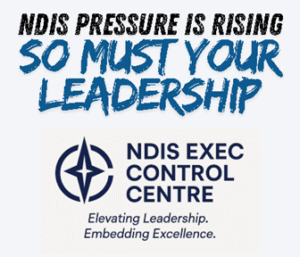Survive & Thrive Series Part 9 – from noise to clarity: turning communication into your strongest safeguard
23 September 2025
Welcome to Part 9 of our Survive & Thrive strategic leadership series for NDIS leaders who want to move beyond surface-level compliance and into transformational leadership.
In Part 8, we detailed how providers can leverage compliance, governance, participant feedback, and advanced Practice Standards to not only meet requirements but also improve participant experiences and gain a real competitive advantage in today’s market through quality practice.
In Part 9, we show leaders how to shift from noise to clarity by turning communication into your strongest safeguard and gain strategic advantage by driving clarity, trust, and decisive action across the organisation.
Why organisations, especially NDIS providers, need clear communication strategies
The NDIS has been in a consistent state of turmoil. Different changes or threats of changes are affecting participants, providers, and the media. Heightening our fight, flight, freeze, or fawn responses, whilst being mindful that as leaders, we do not just carry the responsibility of making decisions. We carry the responsibility of ensuring those decisions are understood, contextualised, and acted on at every level of the business.
All storms eventually pass. It is comforting to look at external factors and say “that was the problem!”. But what really breaks organisations is not the turbulence itself. It is the silence, the half-truths, the lack of follow through, and the unanswered questions that erode trust while the storm is raging.
Have a quick look at your organisational documents. Communication underpins safety, governance, and culture:
“Staff are trained.”
“Families are informed.”
“Participants know their rights.”
These imply communication has happened. Add in your risk registers, policies, and procedures and you probably believe you over-communicate.
However, this information transfer is superficial and undermines the foundations of good communication. Communication is not just a transfer of words, but the creation of shared meaning, clarity, and trust. For this to occur, communication must be:
- Two-way: involves listening and feedback.
- Dynamic: adapts to audience, context, and need.
- Action-oriented: aims to change behaviour, align expectations, or reduce uncertainty.
- Verified: not complete until the other party has understood and can act on it.
Big ask right?
And in the scheme of the storm we are currently in, it would be the simple thing to de-prioritise. But before you make that decision, remember.
Deprioritising communication strategies is one of the most dangerous decisions an NDIS leader can make. Without a deliberate strategy, every message risks getting distorted:
-
- Frontline staff soften feedback to avoid blowback → Risks stay hidden until they explode.
- Middle managers filter issues before they reach the board → Boards make poor decisions without the full picture.
- Executives receive glossy versions of the truth → Staff disengage because they do not feel heard.
- Participants are left navigating systems they barely understand. → Participants lose trust when they get conflicting answers.
🛑 This is not just inefficient. It is dangerous.
Why communication makes or breaks an organisation
- Clarity amidst chaos: Teams do not need polished answers, they need honest updates — what is changing, what is not, and what is still unknown.
- Closed loops build trust: Sharing information once is not enough. Follow up, check back, and confirm it has been received and understood. Communication is not complete until the loop is closed.
- Expectations drive behaviour: If staff do not know what is expected of them during uncertainty, they will fill the void with assumptions. Expectations stated clearly and consistently anchor people in times of disruption.
What a resilient communication plan looks like
- Documented, not assumed: A written plan that outlines who communicates what, when, and how.
- Feedback channels: Two-way communication so leaders can test understanding and surface resistance before it escalates.
- Outcomes over activity: The goal is not sending emails or holding town halls. The goal is reduced anxiety, increased alignment, and staff who know how to act.

The 4 pillars of a strong communication strategy
To move beyond compliance and into genuine governance maturity, providers need to embed strategic communication into their DNA. Using four simple but powerful pillars that make the difference between paperwork and practice.
1. Clarity of purpose
Every message should answer one question: “Why does this matter?”
Too often, staff are told what to do without the why. Policies say “report incidents” but do not explain that early reporting prevents harm. Leaders say “follow the plan” but do not connect it to dignity, safety, or choice.
👉 When the “why” is missing, compliance feels like red tape.
👉 When the “why” is clear, staff lean in because they see impact.
2. Channels & standards
Clarity is not just about what is said, but how and where it is said.
Without standards and usable systems, teams create their own communication shortcuts. House A uses WhatsApp, House B relies on a whiteboard, House C leaves notes in a diary. The result is crucial messages slip through cracks.
A strong strategy sets clear rules of engagement:
- What gets emailed, what gets logged, what gets phoned.
- Timeframes for reporting and response.
- Who is accountable at each stage.
👉 It is not bureaucracy. It is reliability built upon understanding expectations.
3. Feedback loops
This is the most broken part of communication in most NDIS providers, the leader assuming that action alone is enough.
They take steps, fix issues, or make decisions. And then it stops — job done. Or worse, we see some communication and assume someone else has taken it for action, only to discover they have not.
The result is critical actions vanish into silence. Action without communication does not just create inefficiency. It actively undermines resilience and creates large risk blind spots. Without a deliberate communication strategy, your dedicated and tiring work risks being wasted, duplicated, or distorted. That gap between what we do and what others know is where trust unravels, where risks escalate, and where businesses fail.
Staff say: “I reported it, but nothing happened.”
Families say: “We complained, but no one told us what changed.”
Boards say: “We only hear about problems once they become crises.”
👉 Communication without feedback is noise. Communication with feedback is trust. Providers need to close the loop: acknowledge, act, and report back.
4. Consistency across sites
One of the biggest risks in Supported Independent Living (SIL) is inconsistency.
When every house, or even every shift, runs its own version of “the rules,” participants are not experiencing support, they are experiencing chance. Their support depends less on their needs and more on the personal opinion of whoever is rostered that day.
Leaders may believe policies are being followed, but in reality, practice varies wildly across sites. What feels safe and structured at head office often looks fragmented and unpredictable on the floor. This might not seem like a major issue, but often it is the root cause of all other issues.
👉 Why?
- When rules and routines change with each shift, participants cannot trust what will happen day-to-day. For someone with intellectual or psychosocial disability, this unpredictability can create stress, distress behaviours, or withdrawal.
- One staff member might encourage independence, while another might “just do it for them.” Over time, participants stop expecting consistency, and their personal goals are undermined.
- Erosion of trust: Families and advocates quickly notice when communication and practices are inconsistent. Trust in the provider declines, complaints rise, and relationships fracture.
- Variability means greater chance of errors, injuries, or restrictive practices being used differently across shifts. This increases compliance exposure.
- Inconsistent expectations leave staff frustrated. They either disengage (“I’ll just do what I think”) or leave for a more structured workplace.
- More incidents, higher turnover, and constant “firefighting” drive up costs. Resources are wasted responding to preventable problems.
- Inconsistency is hard to hide. If an auditor sees that policies exist but practice varies wildly, it signals poor governance maturity.
The payoff
At its core, communication is culture.
If leaders dodge tough conversations, staff will too.
If managers reward silence, risks will stay buried.
If executives only want “good news”, that is exactly what they will get. Until something explodes.
Culture is what people communicate when no one is watching. A strong communication strategy makes transparency, accountability, and respect the unspoken norm.
This payoff is enormous:
- Participants trust the service because they are consistently heard.
- Staff feel safe and engaged because their voices matter.
- Boards make better decisions because they see reality, not spin.
- Governance matures because communication turns from compliance noise into a driver of outcomes.
The leadership question
Here is the question for executives and boards: “Do we have a communication strategy, or do we just assume messages are landing?”
Because in the NDIS, poor communication is not just inefficient. It is a risk. Good communication is not just a governance tool. It is the foundation of culture and quality.
More than words: communication that makes an impact
The NDIS Executive Command Centre helps leaders:
- Diagnose silent risks within their business.
- Map cultural friction points that drive harm.
- Build leadership capacity for uncertainty and scaling.
- Turn risk intelligence into strategic decisions.
No boardroom posturing. No empty models. Just real tools, real language, real change.
🧭 Ready to stop managing risk and start leading through it?
Join the NDIS Executive Command Centre and finally get ahead of what’s holding your organisation back.

Enjoy unlimited access to all our courses for just A$75.00 per month. Try all courses for 1 month free of charge!
Built for NDIS leaders by NDIS leaders and people receiving NDIS supports.
If you are an owner-operator, director, CEO, GM, or anyone who wants to make a positive impact in the NDIS, this is your go-to learning and reflection space.
Join our upcoming webinar!
Part 9 – From noise to clarity: turning communication into your strongest safeguard
Wednesday, 1 October 2025
11:30 am – 12:30 pm
https://events.teams.microsoft.com/event/17c59c54-7f1c-4e04-a45b-491f9d43490a@d8fe5969-e9bc-4d6b-ba5a-62e8825302c8

Coming next in the final instalment of our NDIS Survive & Thrive series
Part 10 – Identify, plan, monitor, pivot, and know where it is safe to fail
For all the great ideas out there, you are only as good as your implementation. Great ideas are only as powerful as their execution. Remember, what you can measure, you can improve.
Outcome – strategic implementation plans and key indicators of success.
Get involved and get connected!
- We would love to know if you’ve tried any of the activities we’ve suggested or done something similar in the past – and what the outcomes were! You can reach out to us in the Get in Touch section at the bottom of this page.
- We also share practical tips, real life examples, and expert insights every week on LinkedIn. Follow along, join the conversation, and share these posts with your network.
- Join our mailing list here to receive notifications up upcoming instalments and webinars. We truly value the insights and experiences attendees are bringing to our webinars!
How we can help
In today’s climate of tight overhead margins and a competitive labour market, resourcing your transformation team entirely with internal staff may not be feasible. That’s where we come in. Our experienced project and change managers can provide the specialised support you need to keep your transformation on track.
We also offer skilled facilitation for transformation team meetings, maximising your time and ensuring meaningful, high-quality outcomes.
For broader strategic needs, we provide executive advisory and tailored support packages designed to empower NDIS businesses at every stage of growth and development.
Get in touch
If you would like confidential assistance in looking at this differently, book in a time to have a no obligation chat via my bookings calendar or email me at angela@supportingpotential.com.au.
Let’s build a stronger, more adaptable NDIS community, together.
Your partner in achieving compliance, growth and sustainability
Angela Harvey
Managing Director of Supporting Potential
To read all our other blogs visit here




